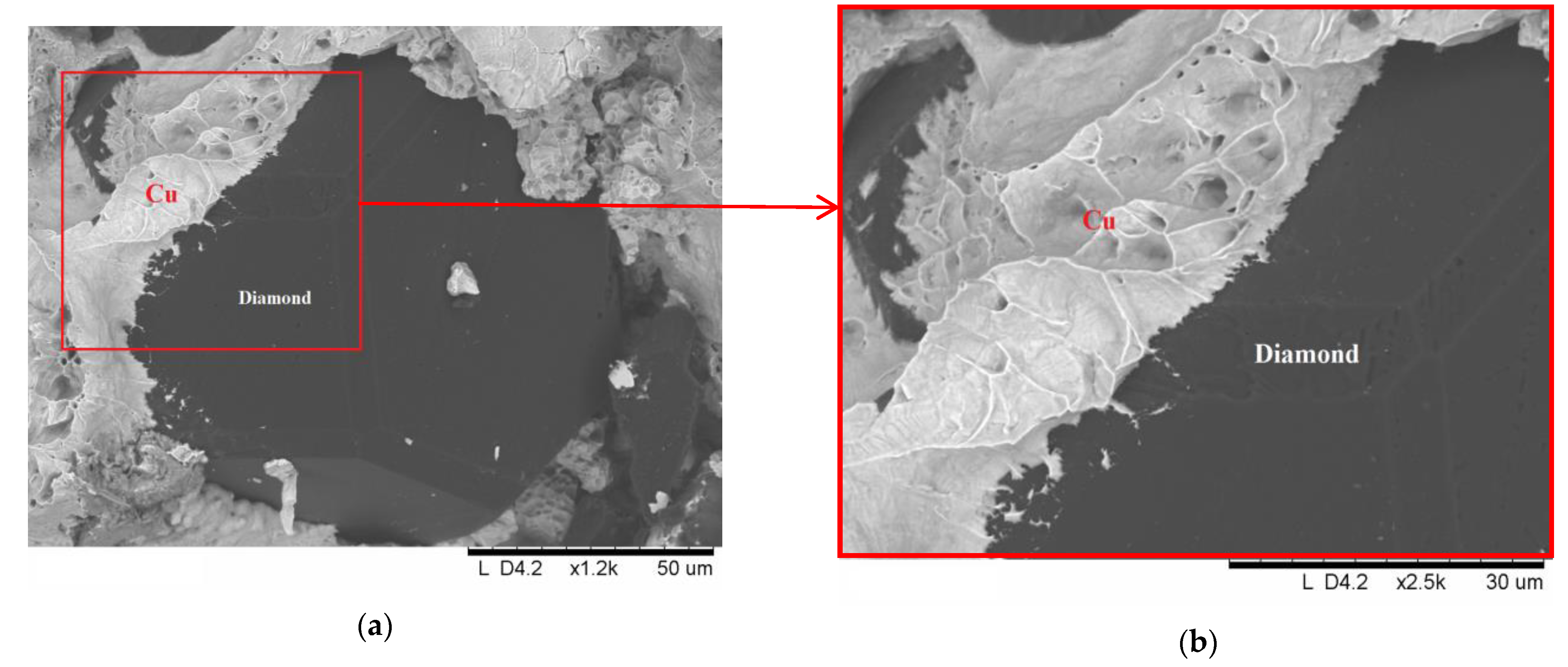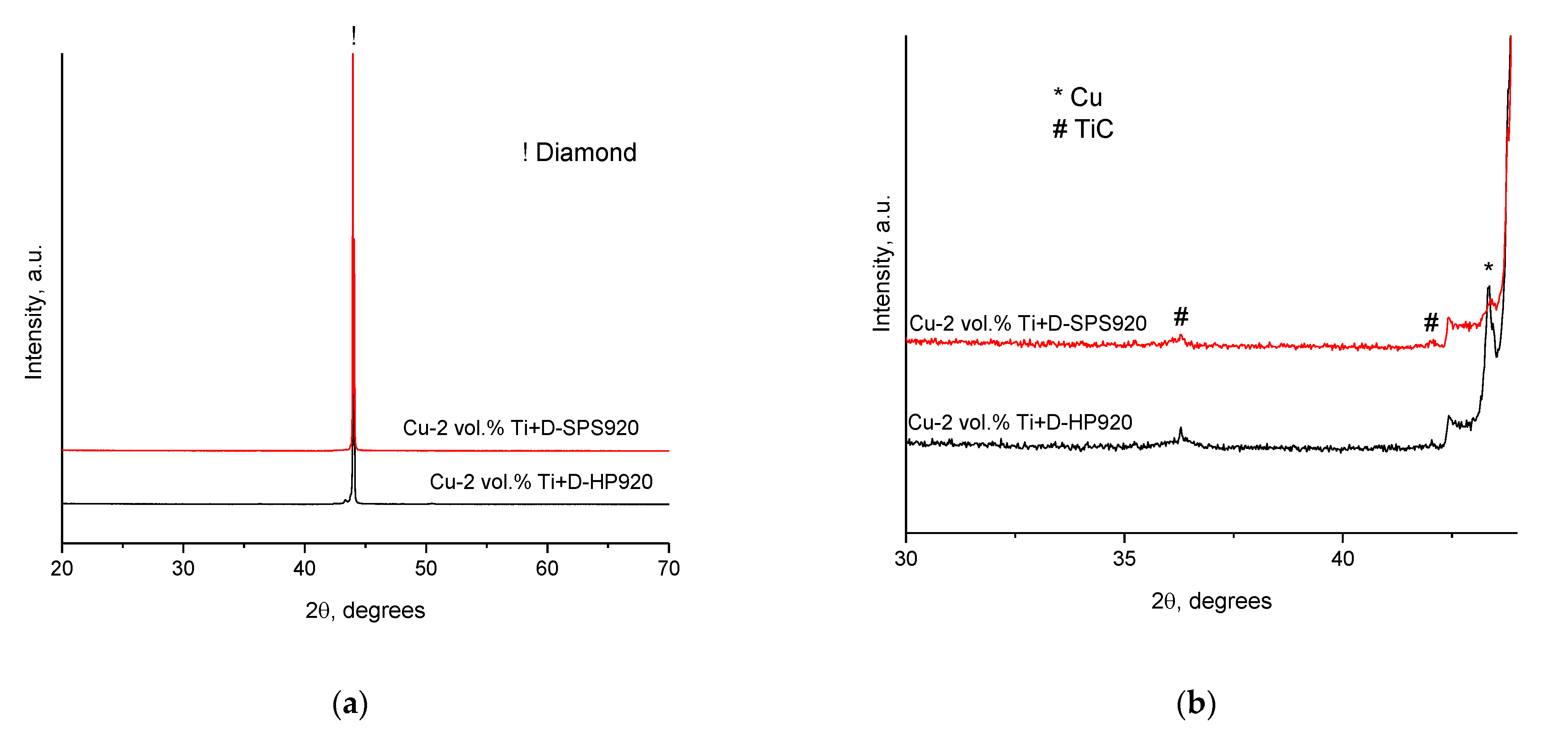The Influence of the Carbide-Forming Metallic Additives (W, Mo, Cr, Ti) on the Microstructure and Thermal Conductivity of Copper–Diamond Composites
Abstract
:1. Introduction
2. Materials and Methods
3. Results and Discussion
4. Conclusions
Author Contributions
Funding
Data Availability Statement
Conflicts of Interest
References
- Miracle, D.B. Metal matrix composites—From science to technological significance. Compos. Sci. Technol. 2005, 65, 2526–2540. [Google Scholar] [CrossRef]
- Yamamoto, Y.; Imai, T.; Tanabe, K.; Tsuno, T.; Kumazawa, Y.; Fujimori, N. The measurement of thermal properties of diamond. Diam. Relat. Mater. 1997, 6, 1057–1061. [Google Scholar] [CrossRef]
- Dai Sh Li, J.; Lu, N. Research progress of diamond/copper composites with high thermal conductivity. Diam. Relat. Mater. 2020, 108, 107993. [Google Scholar]
- Zhou, H.; Ran, M.; Li, Y.; Yin, Z.; Tang, Y.; Zhang, W.; Zheng, W.; Liu, J. Improvement of thermal conductivity of diamond/Al composites by optimization of liquid-solid separation process. J. Mater. Process. Technol. 2021, 297, 117267. [Google Scholar] [CrossRef]
- JunCho, H.; Yan, D.; Tam, J.; Erb, U. Effects of diamond particle size on the formation of copper matrix and the thermal transport properties in electrodeposited copper-diamond composite materials. J. Alloy. Compd. 2019, 791, 1128–1137. [Google Scholar]
- Abyzov, A.; Kidalov, S.; Shakhov, F. High thermal conductivity composite of diamond particles with tungsten coating in a copper matrix for heat sink application. Appl. Therm. Eng. 2012, 48, 72–80. [Google Scholar] [CrossRef]
- Ciupiński, Ł.; Kruszewski, M.; Grzonka, J.; Chmielewski, M.; Zielińsk, R.; Moszczyńska, D.; Michalski, A. Design of interfacial Cr3C2 carbide layer via optimization of sintering parameters used to fabricate copper/diamond composites for thermal management applications. Mater. Des. 2017, 120, 170–185. [Google Scholar] [CrossRef]
- Rape, A.; Liu, X.; Kulkarni, A.; Singh, J. Alloy development for highly conductive thermal management materials using copper-diamond composites fabricated by field assisted sintering technology. J. Mater. Sci. 2013, 48, 1262–1267. [Google Scholar] [CrossRef]
- Chu, K.; Liu Zh Jia Ch Chen, H.; Liang, X.; Gao, W.; Tian, W.; Guo, H. Thermal conductivity of SPS consolidated Cu/diamond composites with Cr-coated diamond particles. J. Alloy. Compd. 2010, 490, 453–458. [Google Scholar] [CrossRef]
- Kang, Q.P.; He, X.B.; Ren, S.B.; Liu, T.T.; Liu, Q.; Wu, M.; Qu, X.H. Microstructure and thermal properties of copper-diamond composites with tungsten carbide coating on diamond particles. Mater. Charact. 2015, 105, 18–23. [Google Scholar] [CrossRef]
- Huang, S.H.; Guo, H.; Zhang, Z.; Zhang, X.M.; Xie, H.F.; Xie, Z.N.; Peng, L.J.; Mi, X.J. Comparative study on the properties and microscopic mechanism of Ti coating and W coating diamond-copper composites. Mater. Res. Express 2020, 7, 76517. [Google Scholar] [CrossRef]
- Lei, L.; Bolzoni, L.; Yang, F. High thermal conductivity and strong interface bonding of a hot-forged Cu/Ti-coated-diamond composite. Carbon 2020, 168, 553–563. [Google Scholar] [CrossRef]
- Wang, L.; Li, J.; Catalano, M.; Bai, G.; Li, N.; Dai, J.; Wang, X.; Zhang, H.; Wang, J.; Kim, M.J. Enhanced thermal conductivity in Cu/diamond composites by tailoring the thickness of interfacial TiC layer. Compos. A Appl. Sci. Manuf. 2018, 113, 76–82. [Google Scholar] [CrossRef]
- Denkena, B.; Krödel, A.; Lang, R. Fabrication and use of Cu-Cr-diamond composites for the application in deep feed grinding of tungsten carbide. Diam. Relat. Mater. 2021, 120, 108668. [Google Scholar] [CrossRef]
- Mizuuchi, K.; Inoue, K.; Agari, Y.; Sugioka, M.; Tanaka, M.; Takeuchi, T.; Tani, T.; Kawahara, M.; Makino, Y.; Ito, M. Effect of chromium addition on the thermal conductivity of Cu/diamond composites fabricated by SPS. J. Jpn. Soc. Powder Powder Metall. 2015, 62, 357–364. [Google Scholar] [CrossRef]
- Mańkowski, P.; Dominiak, A.; Domański, R.; Kruszewski, M.J.; Ciupiński, Ł. Thermal conductivity enhancement of copper–diamond composites by sintering with chromium additive. J. Therm. Anal. Calorim. 2014, 116, 881–885. [Google Scholar] [CrossRef]
- Li, J.; Wang, X.; Qiao, Y.; Zhang, Y.; He, Z.; Zhang, H. High thermal conductivity through interfacial layer optimization in diamond particles dispersed Zr-alloyed Cu matrix composites. Scr. Mater. 2015, 109, 72–75. [Google Scholar] [CrossRef]
- Shen, W.; Shao, W.; Wang, Q.; Ma, M. Thermal conductivity and thermal expansion coefficient of diamond/5 wt% Si–Cu composite by vacuum hot pressing. Fusion Eng. Des. 2010, 85, 2237–2240. [Google Scholar] [CrossRef]
- Tan, Z.; Li, Z.; Fan, G.; Kai, X.; Ji, G.; Zhang, L.; Zhang, D. Fabrication of diamond/aluminum composites by vacuum Hot Pressing: Process optimization and thermal properties. Composites. Pt. B Eng. 2013, 47, 173–180. [Google Scholar] [CrossRef]
- Chen, H.; Jia, C.; Li, S.; Jia, X.; Yang, X. Selective interfacial bonding and thermal conductivity of diamond/Cu-alloy composites prepared by HPHT technique. Int. J. Miner. Metall. Mater. 2012, 19, 364–371. [Google Scholar] [CrossRef]
- Schubert, T.; Trindade, B.; Weißgärber, T.; Kieback, B. Interfacial design of Cubased composites prepared by powder metallurgy for heat sink applications. Mater. Sci. Eng. A 2008, 475, 39–44. [Google Scholar] [CrossRef]
- Chu, K.; Jia, C.; Guo, H.; Li, W. On the thermal conductivity of Cu–Zr/diamond composites. Mater. Des. 2013, 45, 36–42. [Google Scholar] [CrossRef]
- Chung, C.-Y.; Lee, M.-T.; Tsai, M.-Y.; Chu, C.-H.; Lin, S.-J. High thermal conductive diamond/Cu–Ti composites fabricated by pressureless sintering technique. Appl. Therm. Eng. 2014, 69, 208–213. [Google Scholar] [CrossRef]
- Rosinski, M.; Ciupinski, L.; Grzonka, J.; Michalski, A.; Kurzydlowski, K.J. Synthesis and characterization of the diamond/copper composites produced by the pulse plasma sintering (PPS) method. Diam. Relat. Mater. 2012, 27–28, 29–35. [Google Scholar] [CrossRef]
- Mizuuchi, K.; Agari, Y.; Yamada, S.; Inoue, K.; Tanaka, M.; Sugioka, M.; Takeuchi, T.; Tani, J.-I.; Kawahara, M.; Lee, J.-H.; et al. Thermal Properties of Diamond-Particle-Dispersed Cu-Matrix Composites Fabricated by Spark Plasma Sintering (SPS). Mater. Sci. Forum 2010, 638–642, 2115–2120. [Google Scholar] [CrossRef]
- Ukhina, A.; Dudina, D.; Esikov, M.; Samoshkin, D.; Stankus, S.; Skovorodin, I.; Galashov, E.; Bokhonov, B. The influence of morphology and composition of metal–carbide coatings deposited on the diamond surface on the properties of copper–diamond composites. Surf. Coat. Technol. 2020, 401, 126272. [Google Scholar] [CrossRef]
- Tan, Z.; Ji, G.; Addad, A.; Li, Z.; Silvain, J.-F.; Zhang, D. Tailoring interfacial bonding states of highly thermal performance diamond/Al composites: Spark plasma sintering vs. vacuum hot pressing. Composites. Pt. A Appl. Sci. Manuf. 2016, 91, 9–19. [Google Scholar] [CrossRef]
- Ukhina, A.; Dudina, D.; Samoshkin, D.; Galashov, E.; Skovorodin, I.; Bokhonov, B. Effect of the surface modification of synthetic diamond with nickel or tungsten on the properties of copper–diamond composites. Inorg. Mater. 2018, 54, 426–433. [Google Scholar] [CrossRef]
- Ukhina, A.; Dudina, D.; Bokhonov, B. Selective Deposition of Mo2C-Containing Coatings on {100} Facets of Synthetic Diamond Crystals. Int. J. Mol. Sci. 2022, 23, 8511. [Google Scholar] [CrossRef]
- Vidyuk, T.; Dudina, D.; Korchagin, M.; Gavrilov, A.; Skripkina, T.; Ukhina, A.; Anisimov, A.; Bokhonov, B. Melting at the inter-particle contacts during Spark Plasma Sintering: Direct microstructural evidence and relation to particle morphology. Vacuum 2020, 181, 109566. [Google Scholar] [CrossRef]
- Vidyuk, T.; Dudina, D.; Korchagin, M.; Gavrilov, A.; Bokhonov, B.; Ukhina, A.; Esikov, M.; Shikalov, V.; Kosarev, V. Spark plasma sintering treatment of cold sprayed materials for synthesis and structural modification: A case study using TiC-Cu composites. Mater. Lett. X 2022, 14, 100140. [Google Scholar] [CrossRef]
- Dudina, D.; Vidyuk, T.; Korchagin, M.; Gavrilov, A.; Bulina, N.; Esikov, M.; Datekyu, M.; Kato, H. Interaction of a Ti–Cu alloy with carbon: Synthesis of composites and model experiments. Materials 2019, 12, 1482. [Google Scholar] [CrossRef] [PubMed]
- Abedi, M.; Asadi, A.; Sovizi, S.; Moskovskikh, D.; Vorotilo, S.; Mukasyan, A. Influence of pulsed direct current on the growth rate of intermetallic phases in the Ni–Al system during reactive spark plasma sintering. Scr. Mater. 2022, 216, 114759. [Google Scholar] [CrossRef]









| Sample Number | Sintering Method | Additive | Concentrations of the Additive, Cu and Diamond, Vol.% | Sintering Time, min | Relative Density, % | Thermal Conductivity, W m−1 K−1 | ||
|---|---|---|---|---|---|---|---|---|
| Additive | Cu | Diamond | ||||||
| 1 | HP | W | 0.15 | 49.85 | 50 | 15 | 90 ± 1 | 188 ± 9 |
| 2 | HP | W | 0.35 | 49.65 | 50 | 15 | 91 ± 1 | 192 ± 10 |
| 3 | HP | W | 0.7 | 49.3 | 50 | 15 | 88 ± 1 | 203 ± 10 |
| 4 | HP | W | 2 | 48 | 50 | 15 | 90 ± 1 | 172 ± 9 |
| 5 | SPS | W | 0.7 | 49.3 | 50 | 3 | 80 ± 1 | 170 ± 9 |
| 6 | SPS | W | 0.7 | 49.3 | 50 | 10 | 86 ± 1 | 190 ± 10 |
| 7 | SPS | Mo | 0.7 | 49.3 | 50 | 10 | 91 ± 1 | 194 ± 10 |
| 8 | SPS | Cr | 0.7 | 49.3 | 50 | 10 | 89 ± 1 | 385 ± 19 |
| 9 | SPS | Ti | 0.7 | 49.3 | 50 | 10 | 86 ± 1 | 420 ± 21 |
| 10 | HP | Ti | 0.7 | 49.3 | 50 | 15 | 89 ± 1 | 178 ± 9 |
| 11 | SPS | Ti | 0.35 | 49.65 | 50 | 10 | 82 ± 1 | 362 ± 18 |
| 12 | SPS | Ti | 2 | 48 | 50 | 10 | 82 ± 1 | 67 ± 3 |
| 13 | HP | Ti | 0.35 | 49.65 | 50 | 15 | 90 ± 1 | 265 ± 13 |
| 14 | HP | Ti | 2 | 48 | 50 | 15 | 77 ± 1 | 63 ± 3 |
| Sample Number | Concentrations of the Ti, Vol.% | Sintering Method | Cu Lattice Parameter, Å |
|---|---|---|---|
| 1 | 0.35 | HP | 3.6172 ± 0.0014 |
| 2 | 0.35 | SPS | 3.6169 ± 0.0018 |
| 3 | 0.7 | HP | 3.6176 ± 0.0016 |
| 4 | 0.7 | SPS | 3.6181 ± 0.0012 |
| 5 | 2 | HP | 3.623 ± 0.002 |
| 6 | 2 | SPS | 3.6221 ± 0.0016 |
Disclaimer/Publisher’s Note: The statements, opinions and data contained in all publications are solely those of the individual author(s) and contributor(s) and not of MDPI and/or the editor(s). MDPI and/or the editor(s) disclaim responsibility for any injury to people or property resulting from any ideas, methods, instructions or products referred to in the content. |
© 2023 by the authors. Licensee MDPI, Basel, Switzerland. This article is an open access article distributed under the terms and conditions of the Creative Commons Attribution (CC BY) license (https://creativecommons.org/licenses/by/4.0/).
Share and Cite
Ukhina, A.V.; Dudina, D.V.; Esikov, M.A.; Samoshkin, D.A.; Stankus, S.V. The Influence of the Carbide-Forming Metallic Additives (W, Mo, Cr, Ti) on the Microstructure and Thermal Conductivity of Copper–Diamond Composites. J. Compos. Sci. 2023, 7, 219. https://doi.org/10.3390/jcs7060219
Ukhina AV, Dudina DV, Esikov MA, Samoshkin DA, Stankus SV. The Influence of the Carbide-Forming Metallic Additives (W, Mo, Cr, Ti) on the Microstructure and Thermal Conductivity of Copper–Diamond Composites. Journal of Composites Science. 2023; 7(6):219. https://doi.org/10.3390/jcs7060219
Chicago/Turabian StyleUkhina, Arina V., Dina V. Dudina, Maksim A. Esikov, Dmitrii A. Samoshkin, and Sergei V. Stankus. 2023. "The Influence of the Carbide-Forming Metallic Additives (W, Mo, Cr, Ti) on the Microstructure and Thermal Conductivity of Copper–Diamond Composites" Journal of Composites Science 7, no. 6: 219. https://doi.org/10.3390/jcs7060219
APA StyleUkhina, A. V., Dudina, D. V., Esikov, M. A., Samoshkin, D. A., & Stankus, S. V. (2023). The Influence of the Carbide-Forming Metallic Additives (W, Mo, Cr, Ti) on the Microstructure and Thermal Conductivity of Copper–Diamond Composites. Journal of Composites Science, 7(6), 219. https://doi.org/10.3390/jcs7060219








